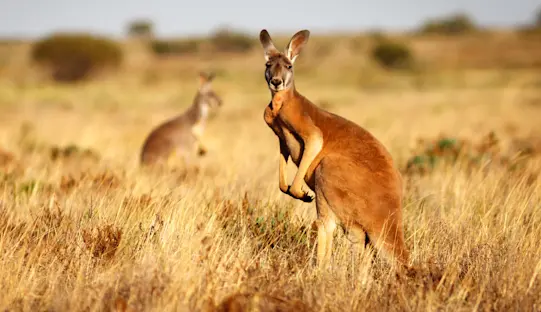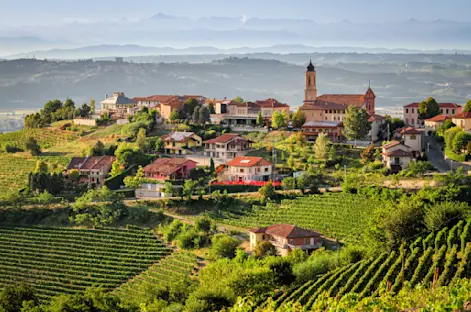
Gophers have small eyes and ears, large front teeth for digging, and a short tail; whereas wolves have large ears, a bushy tail and a more robust build. The two animals are also vastly different in their behaviors and diets. ©David A Litman/Shutterstock.com
On the surface, gophers and wolves don’t seem to have much in common. Gophers are small (just a few inches long), burrowing rodents that primarily consume bulbs, roots and other underground plant parts; while wolves (which can reach several feet in length) are much larger predators that hunt and primarily eat meat. Gophers are solitary creatures, whereas wolves live in complex packs and are highly social. Gophers live in burrows beneath the ground, often in fields and lawns; while wolves can inhabit diverse environments, such as forests, grasslands and tundras.
In Washington state, however, both animals have made surprising—and topsy-turvy—impacts on the landscape.
A modified Mount Saint Helens
Located in Skamania County in the state of Washington about 50 miles northeast of Portland, Oregon, Mount Saint Helens is one of several lofty volcanic peaks that dominate the Cascade Range of the Pacific Northwest. Before May 18, 1980, Mount Saint Helens stood 9,677 feet high. After that date, it was reduced to 8,364 feet.

Before the May 18, 1980, eruption, Mount Saint Helens was a snowcapped, symmetrical beauty and the fifth-highest peak in Washington state. The volcano stood out from its surroundings because of the nearby hills that rose thousands of feet below it.
That’s because at 8:32 a.m. Pacific Daylight Time on May 18, 1980, the volcanic Mount Saint Helens erupted. The eruption—the first in the contiguous United States since 1915—was preceded by a 5.1 magnitude earthquake that triggered a massive landside and lateral blast. The north face of the mountain collapsed into Spirit Lake, crossed a ridge and roared down the Toutle River. The eruption pulverized about a third of the volcano, turning it into ash and mud. The ash plume reached a height of 80,000 feet and blanketed the surrounding area.
The 1980 Mount Saint Helens eruption is often considered the most disastrous volcanic eruption in U.S. history. Natural disasters such as this one can potentially change Earth’s ecological systems. Volcanic ash, debris and lava flows have transformative effects, such as burying vegetation and destroying habitats. Volcanic eruptions may also dramatically affect atmospheric conditions and precipitation—even far from where a blast originated—with extensive implications for both natural landscapes and human systems, such as agriculture, art, industry and religion.
In addition, after volcanic eruptions, patchy mosaics of new soils emerge, yielding shifts in substrate age, soil development and primary successional processes. And as volcanic eruptions resurface landscapes, the effects of the blast also reverberate belowground, as soil microorganisms may aggregate within unaltered areas (as refugia), disassociate with their hosts or perish. Underground ecosystem functions likely diminish following eruptions, which may inhibit microbial activity and reestablishment.

After 1980 on Mount Saint Helens, microorganisms struggled to reassemble beneath the ashfalls and pyroclastic flows. Once the blast of ash and debris cooled, scientists got the idea to give a group of gophers a day job.
Thus, volcanic eruptions hinder nutrient cycling, plant reestablishment and both provision and regulation of ecosystem services. In these novel environments, microorganisms struggle to reassemble beneath the ashfalls and pyroclastic flows.
A gopher guess
Once Mount Saint Helens’ blistering blast of ash and debris cooled, scientists got an idea. They theorized that by digging up beneficial bacteria and fungi, gophers might be able to help regenerate lost animal and plant life on the mountain. The gophers, they believed, would take old soil and move it to the surface, where recovery could occur.
Gophers are considered ecosystem engineers because they change the landscape and the soil’s nutrient availability. They loosen and aerate compacted soil, which helps plants absorb nutrients and water. They bring minerals to the surface through their digging, which can help new soil form. And they play a role in maintaining plant communities that depend on disturbance.

As an experiment, scientists dropped gophers onto parts of the scorched Mount Saint Helens for only 24 hours. The benefits from that single day were undeniable—and still visible 40 years later.
So, about three years after the eruption, scientists from the University of California, Riverside, and Utah State University tested their theory. They were right.
But what the scientists didn’t expect was that the benefits of this experiment would be so long-lived; in fact, they’re still visible in the soil today, almost 45 years later. In a paper that was published in the journal Frontiers in Microbiomes in November 2024, the researchers detail an enduring change in the communities of bacteria and fungi where gophers had been, versus nearby land where they were never introduced.
A growing ground
In 1983, the team from the University of California, Riverside, and Utah State University helicoptered to an area on Mount Saint Helens where the lava had turned the land into collapsing slabs of porous pumice. At that time, there were only about a dozen plants that had learned to live on these slabs. A few seeds had been dropped by birds, but the resulting seedlings struggled.

Just six years post-gopher-experiment, the land exploded again with new life. There were 40,000 plants thriving on the plots that had hosted the gophers. The land without the gophers remained mostly barren.
The scientists dropped a few local gophers on two pumice plots for one day. Six years post-experiment, there were 40,000 plants thriving on the plots that had hosted the gophers. The untouched land remained mostly barren.
All this was possible, say the researchers, because of what isn’t always visible to the naked eye: the mycorrhizal fungi that penetrate plant root cells to exchange nutrients and resources.
Mycorrhizal fungi can help protect plants from pathogens in the soil; and by providing nutrients in barren places, they help plants establish themselves and survive. Apart from a few weeds, most plant roots aren’t efficient enough to get all the nutrients and water they need by themselves. The fungi transport these things to plant roots; and, in exchange, they get the carbon they need for their own growth.

After Mount Saint Helens erupted, ash from the volcano blanketed the trees, trapping solar radiation and causing Douglas fir, pine and spruce needles to overheat and fall from the trees. Here, water flows through the ash at the base of mountain.
A second aspect of this study further underscores how critical these microbes are to the regrowth of plant life after a natural disaster. On one side of the mountain was an old-growth forest. Ash from the volcano blanketed the trees, trapping solar radiation and causing needles on the Douglas firs, pines and spruce to overheat and fall. Scientists feared the loss of the needles would cause the forest to collapse.
But that’s not what happened. The trees have their own mycorrhizal fungi that picked up nutrients from the dropped needles and helped fuel rapid tree regrowth. The trees came back almost immediately in some places. They didn’t all die, as almost everyone thought they would.
On the other side of the mountain, though, the scientists visited a forest that had been clear-cut prior to the eruption. Logging had removed all the trees for acres, so there were no dropped needles to feed soil fungi. Today, there still isn’t much of anything growing in the clear-cut area. The difference between the two areas is shocking, say the scientists.

Today, there still isn’t much of anything growing in the area on Mount Saint Helens that had been clear-cut prior to the eruption.
These results emphasize how much there is to learn about rescuing distressed ecosystems. We cannot ignore the interdependence of all things in nature, conclude the researchers, especially the things we cannot see, like fungi and microbes.
A predator prediction
While one small animal had a big influence on its Washington habitat, a much bigger one, a predator, surprised scientists by hardly having any consequence at all.
Humans drove wolves to extinction in Washington state around the 1930s. Thanks to conservation efforts, by about 80 years later, wolves had returned—crossing first from the Canadian border into Washington around 2008 and later entering the state from Idaho. Since then, wolf numbers in Washington have been steadily growing, raising questions about what the return of this large predator species means for both ecosystems and people.

Wolves returned to Washington state in 2008. Despite their rising numbers, however, wolves are not having much of an impact on white-tailed deer, one of their primary prey.
In northeast Washington, where wolves have recovered most successfully, researchers from the University of Washington, the Washington Department of Fish and Wildlife, and the Spokane Tribe of Indians tracked one of the wolves’ primary prey—white-tailed deer—in part to see what impact wolf packs are having on deer populations.
White-tailed deer are widespread east of the Cascades. The state’s highest-density white-tailed deer population lies within the northeast Washington Predator–Prey Project study area—which includes both agricultural lands and forests recently harvested for timber—in parts of Pend Oreille and Stevens counties in northeast Washington. The location provides deer with high-calorie foraging sites.
According to state researchers, the number of wolves in Washington reached a minimum of 260 in 2023. Four wolf packs reside in the study area; and the total number of wolves—about 23—remained steady overall during the research period.

The biggest factor shaping white-tailed deer populations in northeast Washington state is the quality of habitat available, which is largely determined by human activity.
To conduct the study, researchers radio-collared 280 white-tailed deer, 14 wolves, 33 bobcats, 50 cougars and 28 coyotes from 2016 to 2021. At the time of collaring, the researchers also noted vital statistics, including age, body condition and whether females were pregnant. When collared animals died, the team conducted a mortality investigation, if possible, and attempted to determine the cause of death.
The resulting dataset was used to estimate the growth rate of the white-tailed deer population over the four-year study period and to identify the major factors shaping it. In a paper published in June 2024 in the science journal Ecological Applications, the researchers report that the biggest factor affecting white-tailed deer populations in northeast Washington is the quality of habitat available, including the amount of forage obtainable by deer. For these animals, who are highly adaptable to human activity, foraging sites can range from forests and shrublands to agricultural fields. Following habitat quality is predation by a different, long-established, large predator in the state: the cougar, also known as the mountain lion or puma. Wolves are a distant third in their impact. Bobcats and coyotes—both medium-sized predators—have a negligible impact on deer numbers.
But it’s not that wolves aren’t preying on white-tailed deer, state the researchers. There’s just not enough of them to take a large bite out of the deer population as a whole. These findings contrast with studies of long-established wolf populations in protected areas, like Yellowstone National Park, which show a higher impact of wolves on the population dynamics of their prey species. To the authors of this new study, those differences highlight the importance of studying wolves in a variety of habitats.

The second biggest factor affecting white-tailed deer populations in northeast Washington state is predation by cougars, also known as mountain lions or pumas.
The scientists conclude that prior to this study, one might have expected that relying solely on wolf management strategies would result in a booming deer population, when it is clearly more complex than that. Wolves are not returning to empty landscapes, such as national parks or dense, old-growth forests. They’re going to places with humans—and their active farming, logging, ranching and towns—and other carnivore species, like cougars, which all will likely limit the impact wolves have on one of their primary food sources. Thus, the population dynamics of predator and prey species can vary dramatically, and it’s critical to compare different types of sites.
A concept challenged
After Washington’s Mount Saint Helens erupted in 1980, scientists thought they were just testing a short-term reaction. Who would have predicted that you could invite a few gophers in for a day and see a residual effect 40 years later? On the other hand, in 2021, researchers predicted that a much bigger animal, the wolf, would make a huge mark on Washington’s deer population. They hardly made a dent.
Nonhuman animals are constantly surprising us, proving themselves to be capable of empathy, intelligence and thought in ways we never expected. And many of them exhibit unexpected abilities, behaviors and physical feats that can challenge our common perceptions.
And, I think, it’s when our perceptions are challenged that we truly learn.
Here’s to finding your true places and natural habitats,
Candy






























